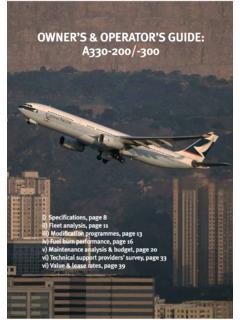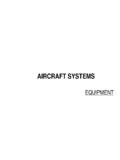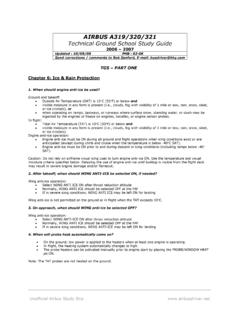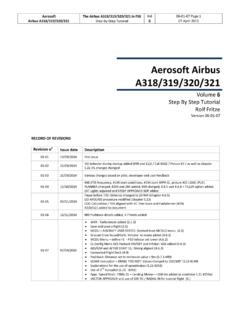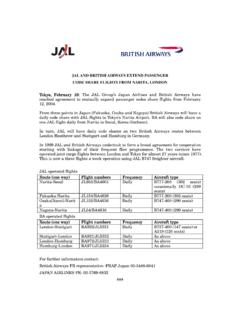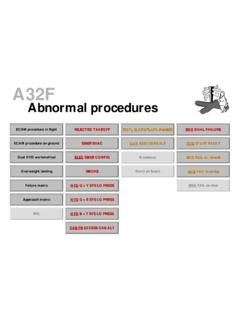Transcription of AIRCRAFT OWNER’S & OPERATOR’S GUIDE: A320 …
1 AIRCRAFT owner S & operator SGUIDE: a320 FAMILYi) AIRCRAFT specifications, page 6ii) Production & fleet analysis, page 9iii) Major modification & upgrade programmes, page 14iv) AIRCRAFT operating performance, page 16v) Maintenance requirements & analysis, page 18vi) Values, lease rates & aftermarket activity, page 32 AIRCRAFTCOMMERCEISSUENO. 44 FEBRUARY/MARCH20066 IAIRCRAFT owner S & operator S GUIDEThe evolution of the a320 familyhas led to four main variants:the A318, a319 , a320 andA321. These share a commonfuselage design, with a standard six-abreast economy class configuration, andhave different lengths that accommodatebetween 107 and 185 seats. The range ofseat sizes is similar to that offered by the737NG family, although the A321 hasfive more seats than the 737-900ER. The fuselage is known for itspassenger comfort, offering 1-inch widerseats than its 737/757 rivals.
2 The A320family s main features, however, are: itsfly-by-wire (FBW) flight control system; acommon flightdeck and single pilot typerating; and use of common engine typesand rotable components in two or moreof its variants. These features give a highlevel of commonality that providesreductions in flightcrew- andmaintenance-related operating costs. TheFBW flight-control system and commonflightdeck not only allow the single typerating between the four variants, but alsocross-crew qualification with otherAirbus types that have FBW systems andthe same or similar flightdecks. These technical features and a widerange of seat capacities, which satisfymany airlines requirements, make theA320 family an attractive choice. a320 The a320 family s principal variant isthe a320 . Its cabin allows 150 seats in atwo-class layout (see table, page 7)of 12first-class and 138 economy seats.
3 Thiscan be increased to 164 seats in an all-economy layout at 31-inch seat pitch, oras many as 180 seats at 29-inch seatpitch. The initial a320 model, the a320 -100, has a fuel capacity of 4,185 USGallons (USG) and maximum take-offweight (MTOW) of 145,504lbs. It ispowered by CFM56-5A1 engines, ratedat 25,000lbs thrust. Its combination ofgross weight and fuel capacity give it arange of about 1,800nm with a load of164 passengers. This initial model was not ordered inlarge numbers, since most potentialcustomers showed more interest inhaving a higher gross weight and fuelcapacity. Only 19 -100 series aircraftwith CFM56-5A1 engines were orderedby British Caledonian, Air Inter and AirFrance. Two have been destroyed,leaving just 17 in operation with BritishAirways and the Air France group. A higher weight a320 -200 modelwas also available from initial offeringsto potential customers.
4 This used thesame CFM56-5A1 engine, but had ahigher MTOW of 162,040lbs ( ) and fuel capacity of 6,300 weight variant has a range of2,600nm (see table, page 7). Later developments with the CFM56engine led to an AIRCRAFT powered by theCFM56-5A3 rated at 26,500lbs thrustand with an MTOW of 166,450lbs ( ), while sharing the same fuelcapacity of 6,300 USG. This weightvariant has an extended range of2,850nm (see table, page 7). The CFM56-5A series could not bedeveloped much further in additionalthrust. Because this would prevent the -5A series being used on the stretchedA321, the CFM56-5B series wasdeveloped to provide higher thrustgrowth potential. The CFM56-5B series main difference over the -5A was anadditional high- pressure compressor(HPC) stage. Both variants have a wide intake fan and utilise a single-stage high-pressure turbine (HPT).
5 Theadditional HPC stage allowed theCFM56-56B to be developed up to arating of 33,000lbs thrust, therebyenabling the engine to be employed for awider range of variants. The CFM56-5B4, rated at 27,000lbsthrust, was first offered on the a320 inthe mid-1990s. The -5B series was usedto power the highest MTOW variant ofthe a320 , which had a gross weight of169,750lbs ( tonnes). With the samestandard fuel capacity of 6,300 USG, theaircraft had a range of 2,850nm. The same weight variant is alsoavailable with supplementary fuel tanks,taking total capacity to 7,066 USG, andgiving the AIRCRAFT a range of 3,050nm(see table, page 7). Airbus offers customers flexibility inthe a320 family with several enginethrust variants of the two main enginetypes for each MTOW variant. The threeMTOW variants of the a320 are162,050lbs ( tonnes), 166,450lbs( tonnes) and 169,750lbs ( ).
6 Each can be powered by threevariants of the CFM56-5B: the -5B4rated at 27,000lbs thrust; the -5B5 ratedat 22,000lbs thrust; and the -5B6 rated at23,500lbs thrust (see table, page 7). A320familyspecificationsThe a320 family has four main variants. Each hasseveral gross weight and engine options to choosefrom, making many combinations possible. There are five gross weight variants of the a320 -200, and CFMI offers two variants of theCFM56-5A and three variants of the -5B series. In most cases airlines select a highgross weight and high-thrust airframe-engine combination, with high-ratedengines providing better fieldperformance but higher fuel burn (seeA320 family fuel burn performance, page16). Airlines may select a lower-ratedengine for high gross weight AIRCRAFT ,however. Other developments of the -5B4employed a dual annular combustor(DAC) to reduce NOx emissions.
7 Alongside the CFM56, InternationalAero Engines (IAE) developed for use on the first models ofthe a320 -200 in 1988, which were ratedat 25,000lbs thrust. No -100s wereequipped with the The first a320 -200had the same MTOW of 162,040lbs( tonnes) and fuel capacity of 6,300 USG, as the CFM56-5A1-poweredaircraft. This gave it a range of 2,600nm(see table, this page). The was developed with athrust bump, which gave the engine arating of 26,500lbs thrust for take-off inhot and high conditions. This engine wasused to power AIRCRAFT with an MTOWof 166,450lbs ( tonnes), a fuelcapacity of 6,300 USG and range of2,870nm (see table, this page). Like the CFM56, the had tobe adapted to provide enough power forlarger developments of the AIRCRAFT . TheV2500-A5 series was therefore evolved,its key differences over the -A1 seriesbeing an increase in fan width from 63 inches, and a higher coreflowallowing higher thrust ratings.
8 There arefive -A5 series variants rated at between23,000lbs and 32,000lbs thrust. The was developed for theA320-200, rated at 26,500lbs is used to power the three grossmodels of the a320 , the highest of whichis 169,750lbs ( tonnes), and has arange of 2,870nm with the standard fuelcapacity of 6,300 USG. Withsupplementary fuel tanks and a totalcapacity of 7,066 USG, the AIRCRAFT srange is extended to 3,050nm. A321 The A321 was the second variant tobe developed, following large sales of thesimilarly-sized 757 in the 1980s. TheA321 has a standard two-class seatcapacity of 185, about 10 seats fewerthan the 757-200 when the two aircraftare similarly configured. The first orders for the AIRCRAFT were7 IAIRCRAFT owner S & operator S GUIDEISSUENO. 44 FEBRUARY/MARCH2006 AIRCRAFTCOMMERCEA320 FAMILY SPECIFICATIONSA320-100-200-200-200-200-2 00 MTOW lbs145,504162,040166,450162,050166,45016 9,750 MTOW seats150150150150150150 Engine variantsCFM56-5A1 CFM56-5A1/CFM56-5A3/CFM56-5B5/CFM56-5B6/ CFM56-5B4 volume USG4,1856,3006,30022,00023,50027,000 Range nm1,8002,600/2,850/2,600/2,850/2,850/2,6 002,8702,6002,8702,870 Supplementary fuel7,066volume USGR ange nm3,050A321-200-200-200-200 MTOW lbs183,000187,400196,200206,130 MTOW seats185185185185 Engine variantsCFM56-5B4/CFM56-5B1/CFM56-5B2/CF M56-5B3 volume USG6,2606,2607,0407,800 Range nm2,200/2,340/2,670/3,000/2,2002,3702,70 03,000A319-200-200-200-200 MTOW lbs141,100149,920154,330166,450 MTOW seats124124124124 Engine variantsCFM56-5A4/-5A5/CFM56-5B5/CFM56-5 B6/CFM56-5B7 volume USG6,3006,3006,3006,300/7,070/7.
9 830 Range nm1,8002,6002,9503,050/3,450/3,700A318-2 00-200-200-200-200-200 MTOW lbs130,070135,580138,890142,200145,50014 9,900 MTOW seats106106106106106106 Engine variantsCFM56-5B8 CFM56-5B8 CFM56-5B8 CFM56-5B9 CFM56-5B9 CFM56-5B9PW6122PW6122PW6122PW6124PW6124P W6124 Fuel volume USG6,3006,3006,3006,3006,3006,300 Range nm1,450/1,950/2,200/2,500/2,800/3,200/1, 4001,8502,1502,4502,7003,100placed in 1989. Like the a320 , the initialA321 models were light and had a short-range capability. There are five MTOW variants of theA321: 183,000lbs ( tonnes);187,400lbs (85 tonnes); 196,200lbs ( ); 205,000lbs ( tonnes); and206,130lbs ( tonnes). These are all available with thestandard fuel capacity of 6,260 USG, butthere are also two options forsupplementary fuel tanks that take totalcapacity to 7,040 USG and 7,800 with the a320 , there are severalengine thrust variants available for theCFM56-5B and : the CFM56-5B4 rated at 27,000lbs thrust); -5B1rated at 30,000lbs thrust; -5B2 rated at31,000lbs thrust; and the -5B3 rated at33,000lbs thrust.
10 Each is available for allthe five different gross weight variants. When equipped with CFM56-5 Bengines, the tonne and tonnevariants have a range of 2,200nm and2,340nm with a standard fuel capacity of6,260 USG (see table, page 7). The gross weight AIRCRAFT has a range of2,670nm, and the tonne grossweight AIRCRAFT has a range of 3,000nm(see table, page 7). Only 18 AIRCRAFT are equipped withCFM56-5B1 engines; these are operatedby Air France, Swiss and AustrianAirlines. Another 14 have CFM56-5B2engines and are in operation withAlitalia, an early customer for the A321. More than 170 AIRCRAFT with -5B3engines have been ordered to date. There are two variants of the available for the A321: the rated at 30,400lbs thrust; and rated at 33,000lbs thrust. When equipped with , AIRCRAFT with a gross weight tonnes and tonnes andstandard fuel capacity of 6,260 USGhave a range of 2,200nm and 2, with a gross weight of and fuel capacity of 2,700nm, orwith a gross weight of tonnes andfuel capacity of 7,800 USG, have a rangeof 3,000nm.
